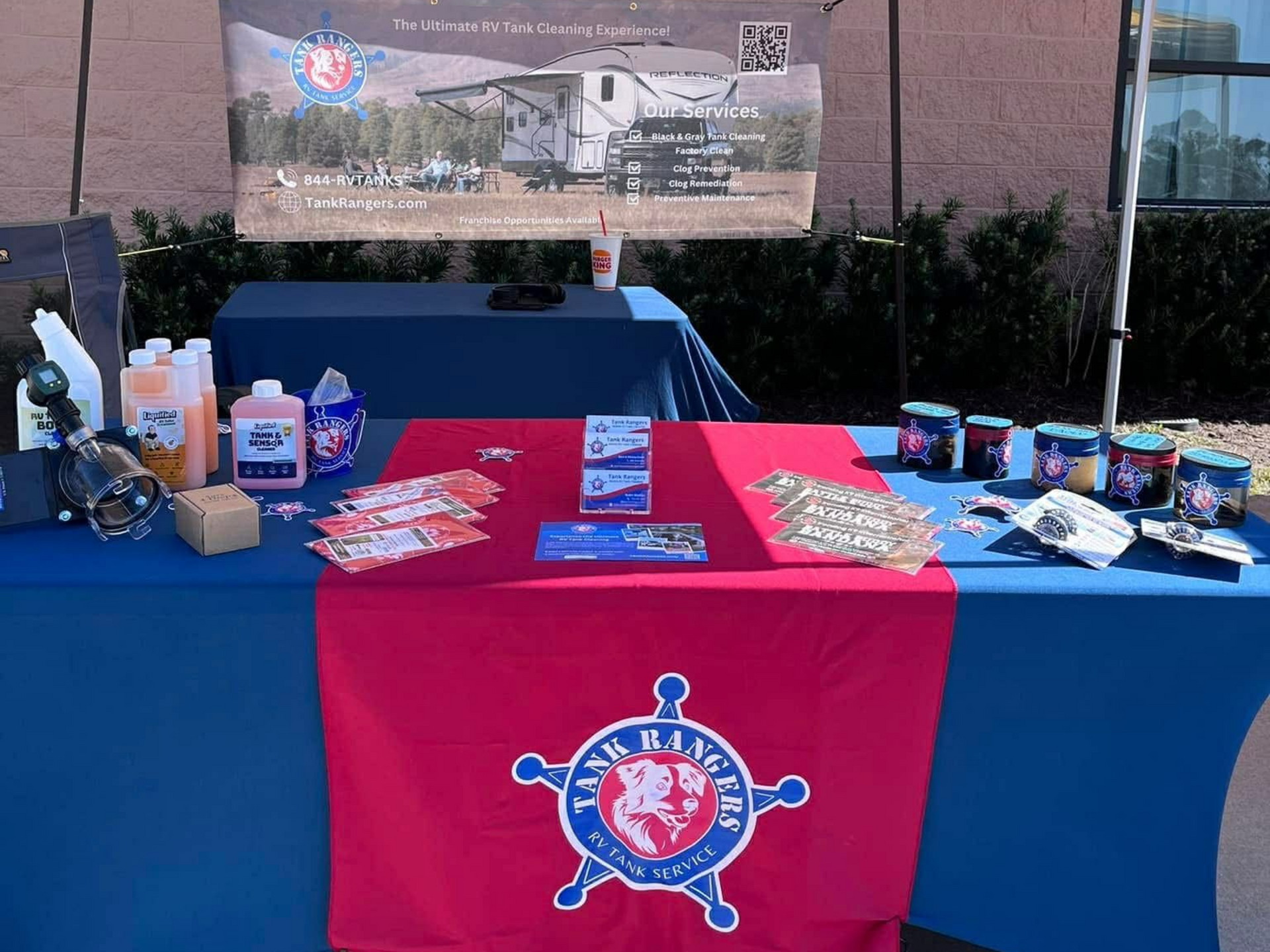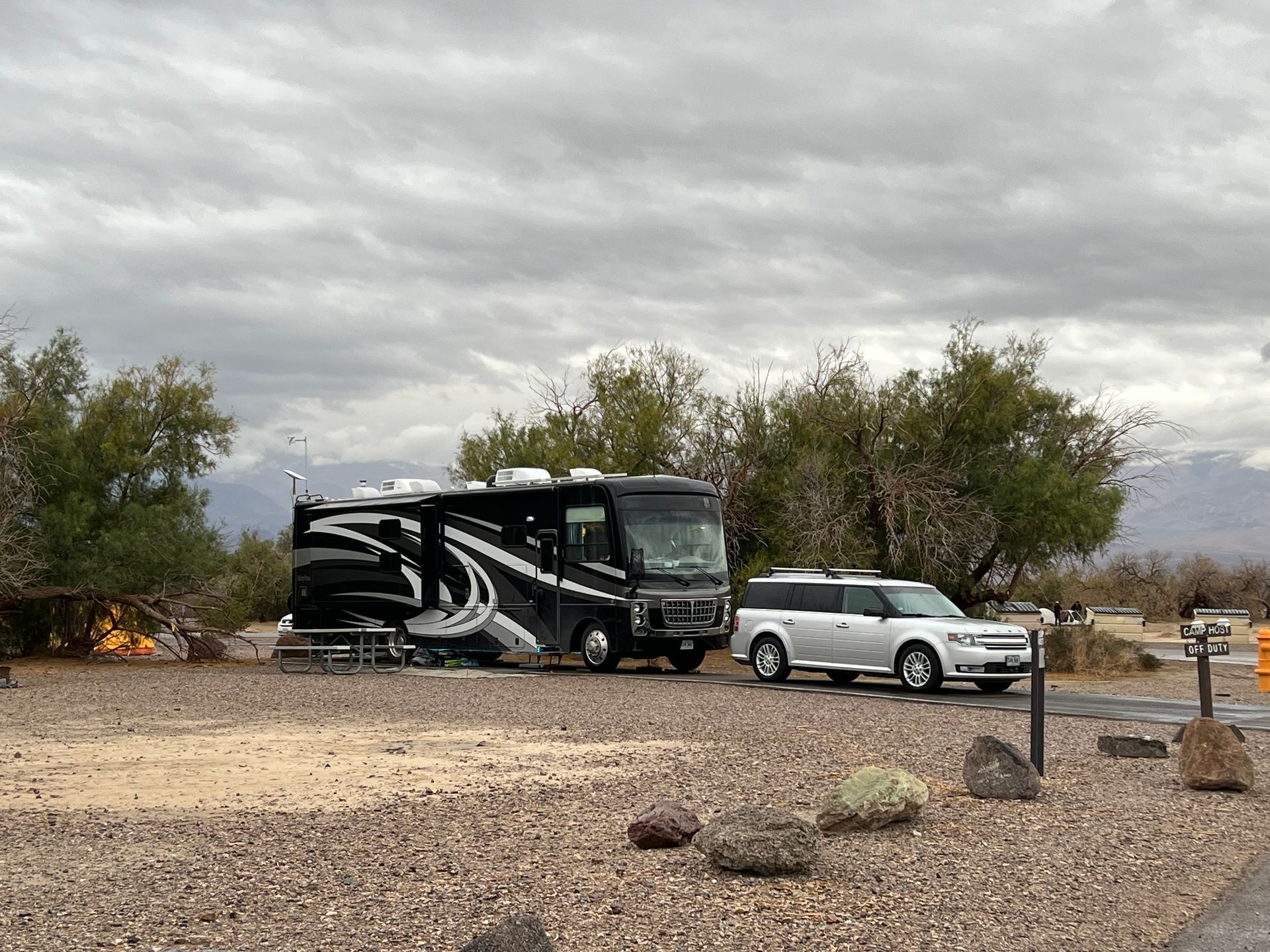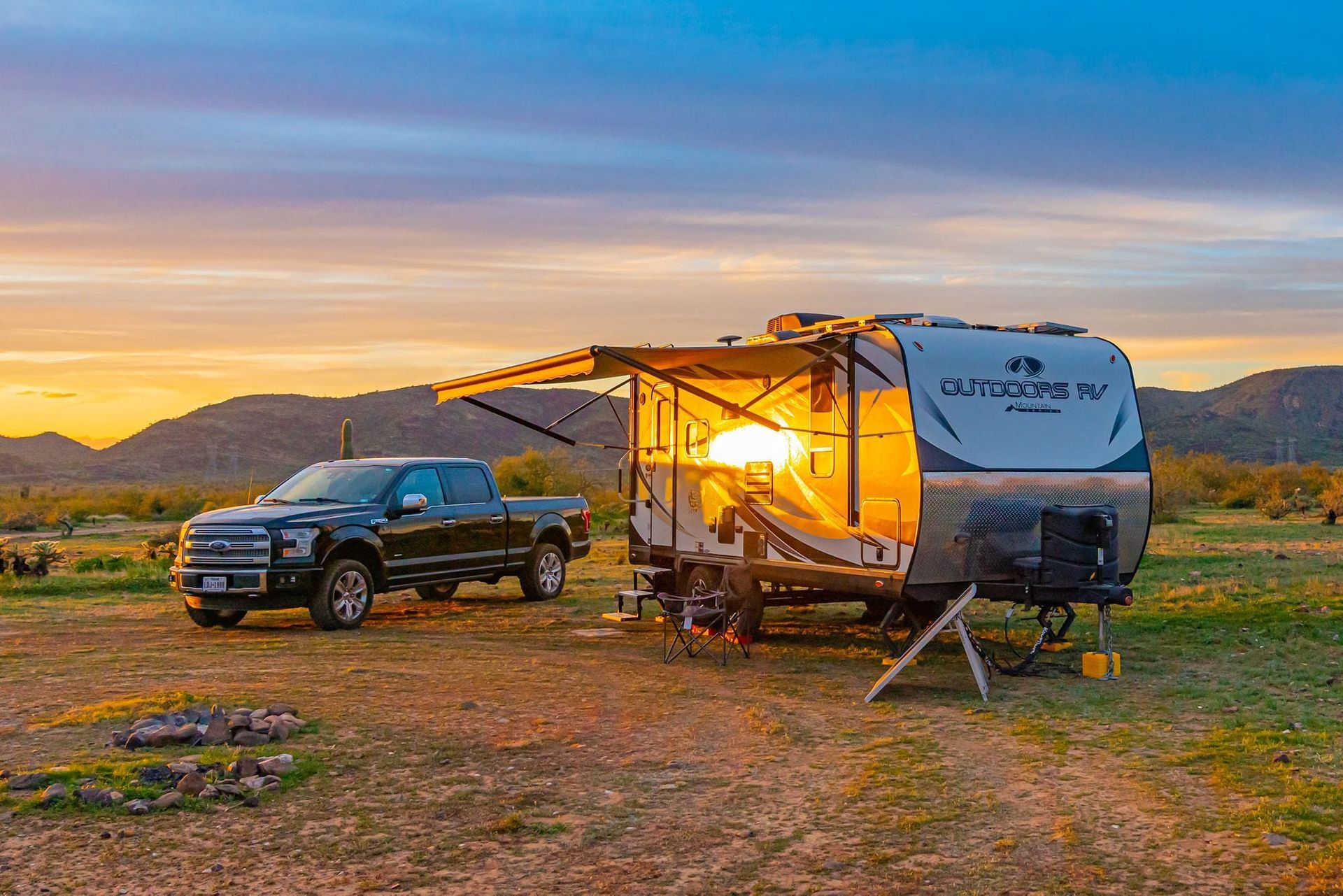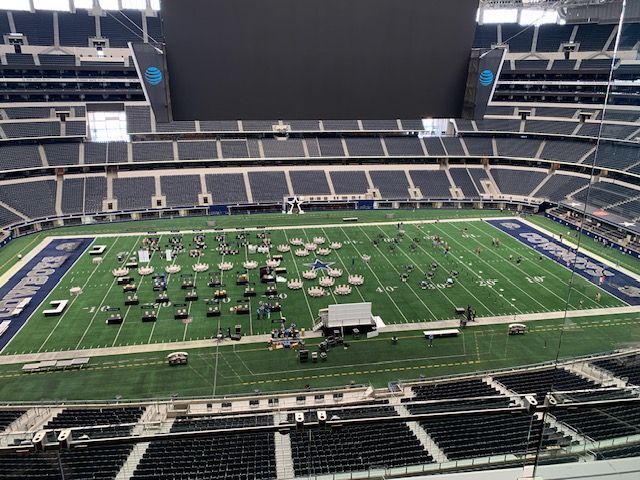The Great Texas Freeze
Michael Gardner • September 5, 2025
February 2021
We had been hanging around southeast Texas for months– all with the intent of avoiding the cold winter back home in Central Illinois. So much for that. We were hanging out in a Thousand Trails north of Houston (Lake Conroe). We tend to watch the weather closely and we saw WINTER was coming.
Temperatures down here had been lows between 30 and 40 degrees and highs 50-60. Not great weather, but not terrible either. A small heater in the water bay was enough to keep it from freezing. I even dressed in shorts some unusual days when temps were in the 70’s. Weather forecasts say we have lots of 70s days coming, but not until after a week more of this slush, ice and cold.
We had started seeing references to Artic blasts, Polar vortexes and such, a week out. Having spent time in very cold weather and realizing just how ill-equipped most south Texans would be dealing with Real Winter Weather, we started prepping. Food and supplies were gathered. We knew from the get-go we didn’t want to be out on the roads when the white stuff hit the highways. Driving with these people on dry roads on sunny days was bad enough. There was no way we wanted to be on slippery roads with inexperienced winter drivers. As the impending storms drew close, the forecasts continued to get even worse. A last-minute safari was deemed necessary as we realized our RVs were not going to survive the cold temperatures on their own. The wives managed to snag another small space heater and a string of construction lights along with some additional extension cords.
When we went to Wisconsin in the dead of winter, we took 4 space heaters, pink foam board to put around our bedroom slide and a full RV, homemade skirt. We also left the main slide in to minimize exposed surface area and all the air leaks around the slide.
Now we had two small heaters in our RV and one for our daughter’s. We both had electric fireplaces. During the shopping safari, no regular trouble lights could be found. These are a common way to keep water bays from freezing. A hundred watts here and there to keep temps above freezing. For our RV – we started with one light in our water bay. I also had battery warmers installed around our Lithium block. I had remote temperature sensors in a couple places, including the water bay and I quickly realized the one light wouldn’t be enough to keep the bay from freezing and had to move one of the small space heaters in there. It had a thermostat, so with a little trial and error, I could find the setting to keep the temps in there between 50 and 60 degrees. All well and good. But life is never that simple.
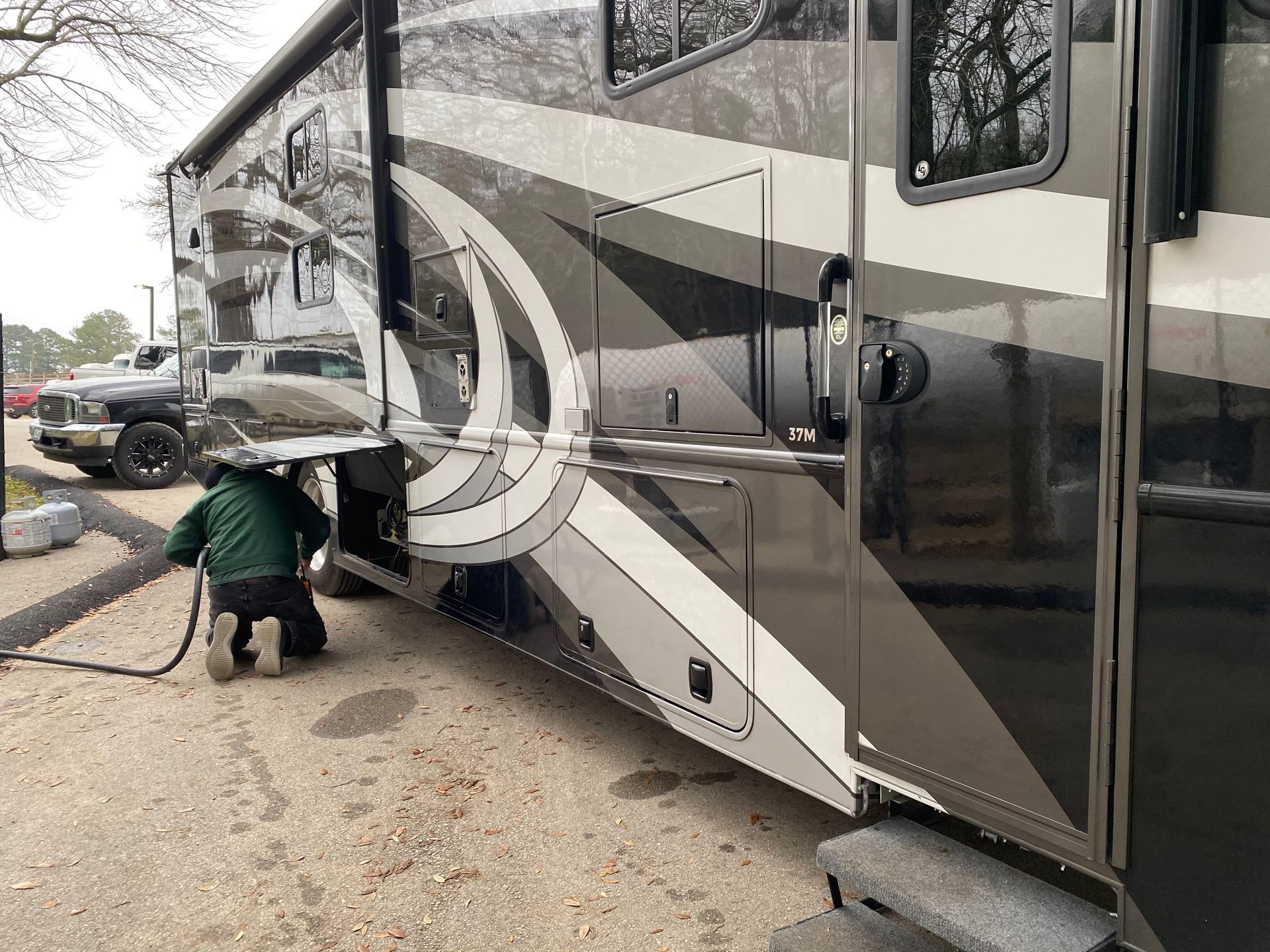
Our daughter’s RV had three water bays and a block of Lithiums in a separate battery bay. I took the string of 5 construction lights and cut them apart and merged them with a set of extension cords – creating 5 separate 100-watt trouble lights. Two went into her main water bay, one each in the other two (which just were tank dump locations) and the fourth went into the battery bay along with all my remaining Reflectix insulation to create a heated space around the batteries.
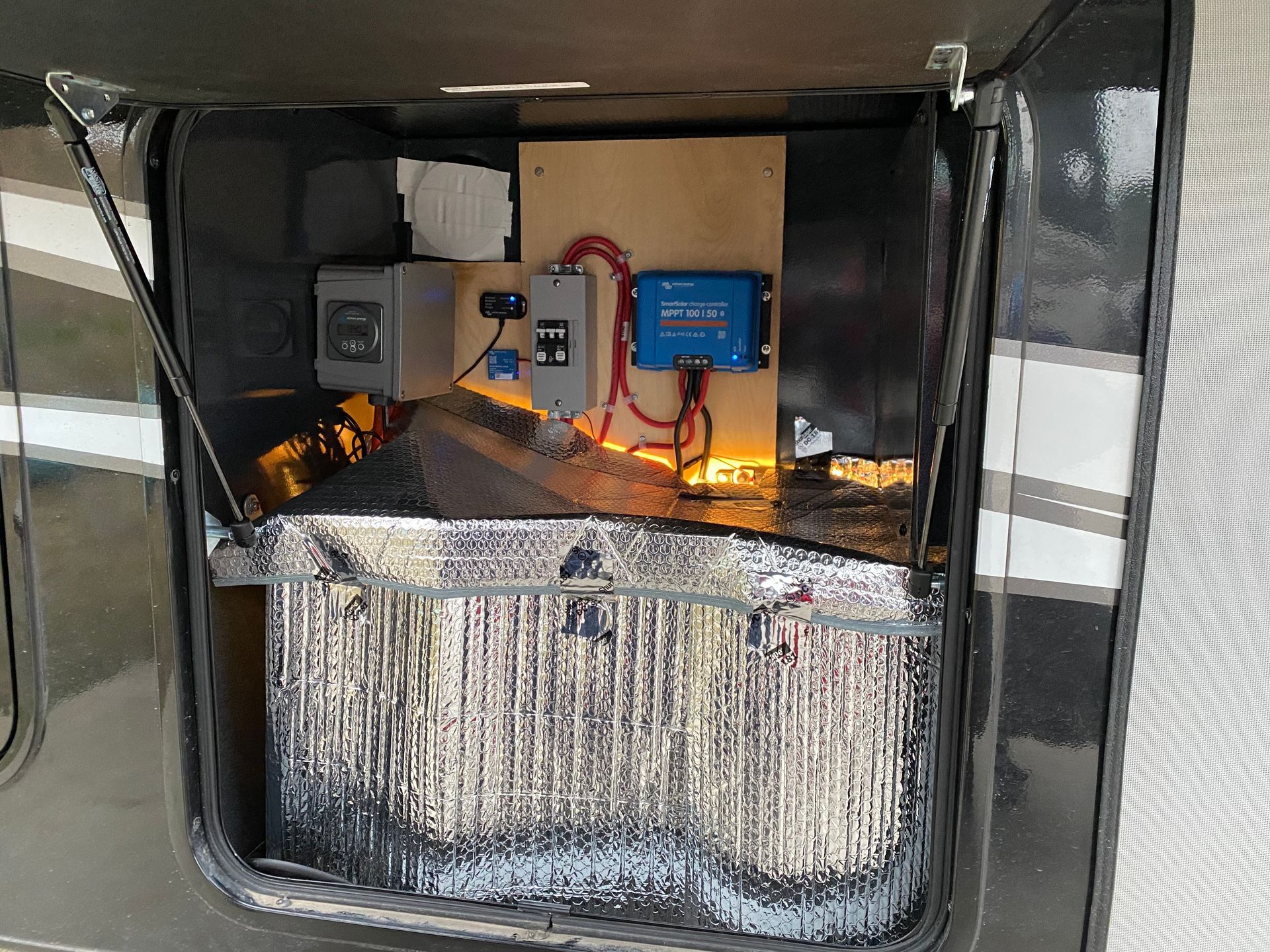
Our propane tank was nearly full, but our daughter’s tank wasn’t. Early in the process we packed up their RV quickly and managed to get the propane tank filled at the campground before the last-minute rush started.
All ready for a bit of cold, right?
All our planning up to this point, ASSUMED that our 50-amp campground pedestals would continue working. Why wouldn’t they? We were not far from a major city (Houston), and near an interstate and a medium sized city. There were lots of power lines around, major power lines. Power in the campground was all underground, safe from trees. Not so fast.
The first morning of the cold wave, we woke shortly after 4 am – which was about the time my Victron power system says power went out. Now for many things in our RV, we can function without campground power. We have 400 amp-hours of lithium and a 3000-watt inverter and lots of solar. But, battery heaters, space heaters and the propane furnace use a lot of electricity. And in our daughter’s RV, there were all those 100-watt bulbs and a space heater and an electric fireplace – suddenly mother nature changed all the rules in a game we thought we had a good chance of winning.
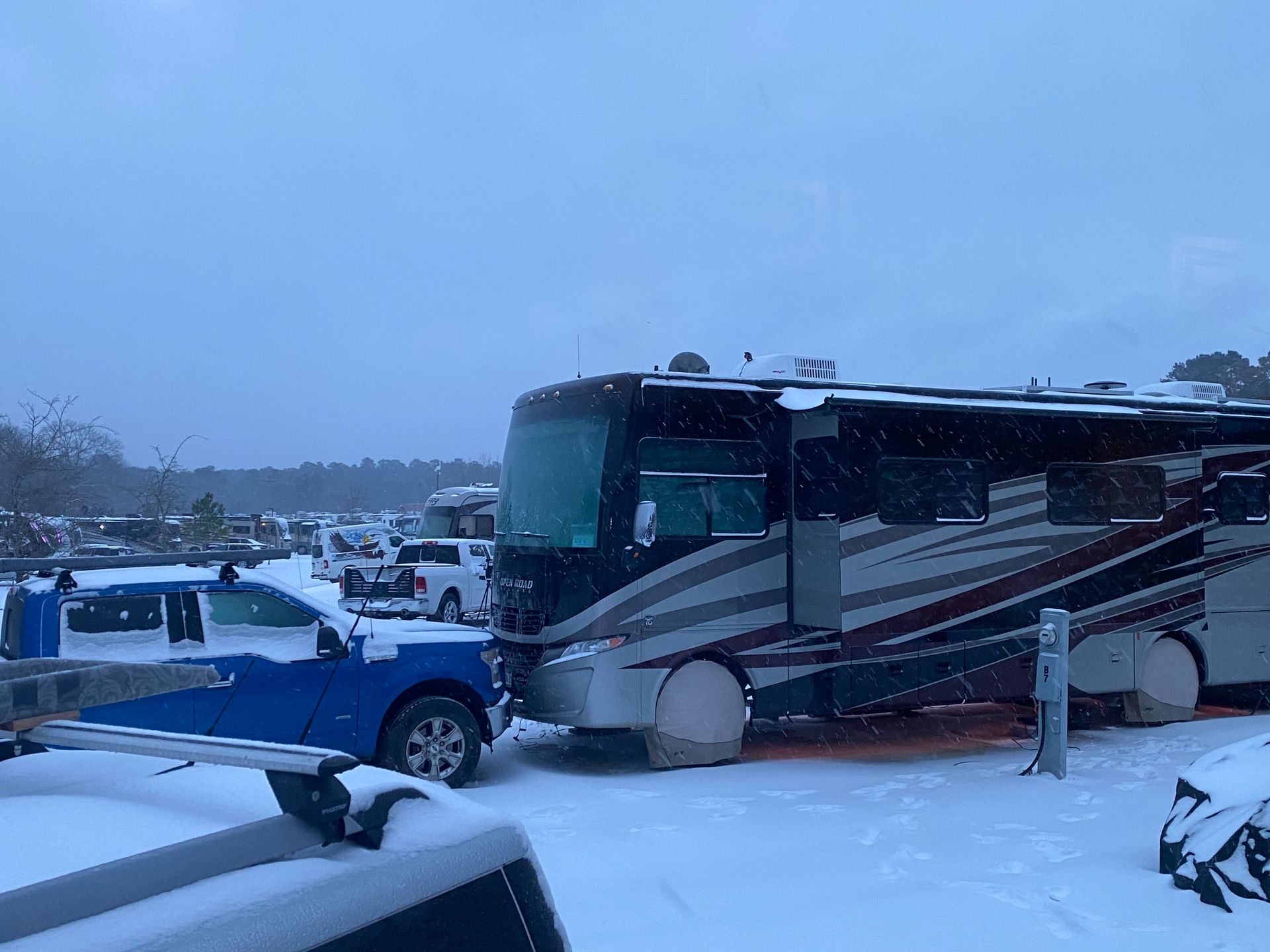
It all became about resource management. We both have built in generators. But built-in generators use gasoline out of the RV’s main tank. But the pickups are set at about ¼ tank level so the generator can’t run the tank dry. So, we are told and hoped it was true because one RV didn’t have a full tank of gas (one did). Generators use around 1/3 to 2/3rds of a gallon per hour, so running the generator for 8 hours a day or more starts to add up. When we can use the space heaters and fireplace, we don’t use nearly as much Propane as when we have to rely on the propane for ALL our heat. We needed to fill our water tanks and put hour hoses away which we did. We needed to watch our water bay temperatures. We needed to watch our propane tanks, and we needed to watch our gas tanks as well. Oh, and walk the dogs several times a day.
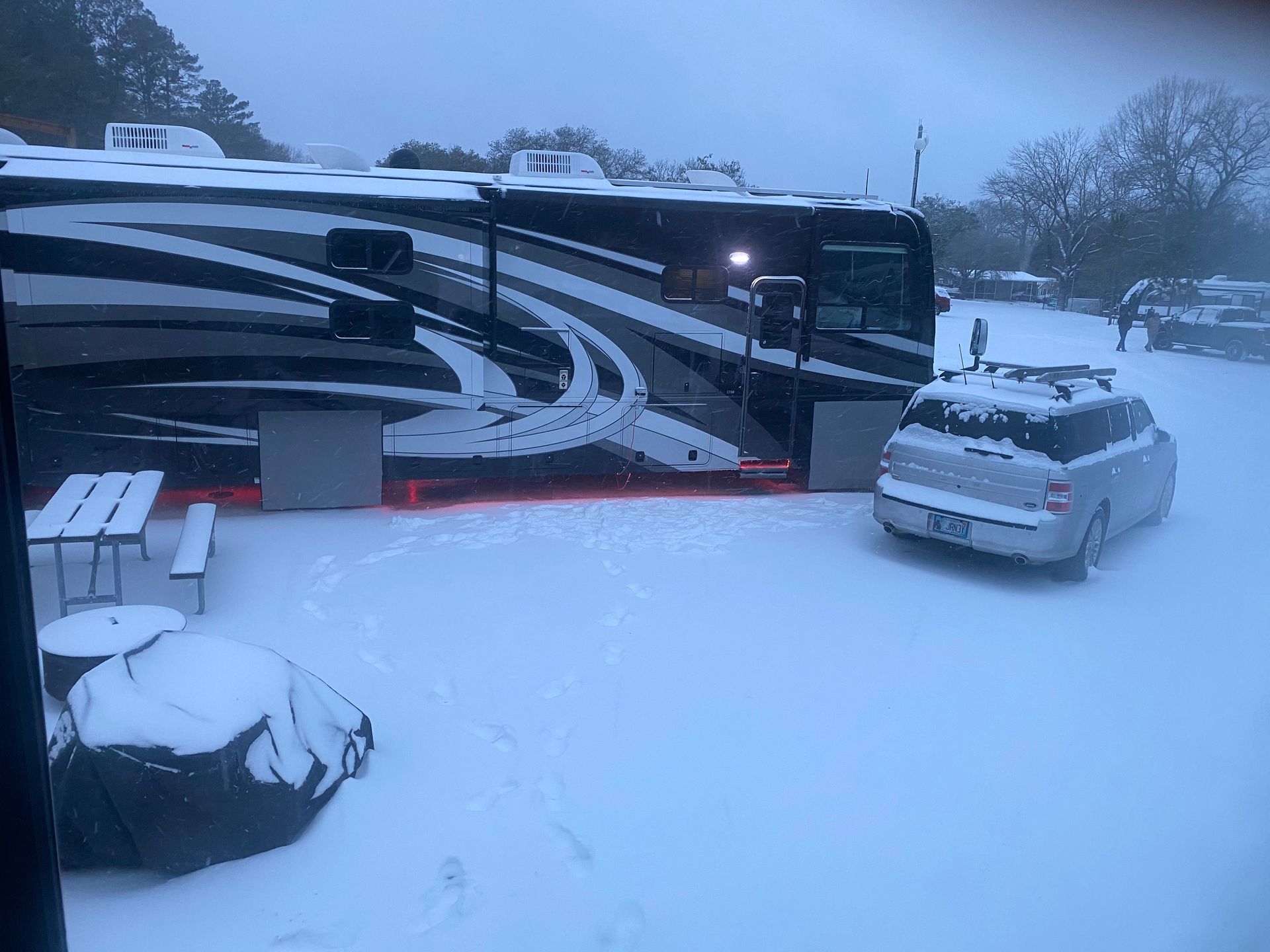
We have 800 watts of solar, but cloudy days and a thick coating of ice and snow meant little help from solar until the second day when we got just enough warmth and sun to clear off the panels. To top it off, there are different flavors of power, available and limited by the design of our RV system. Our generator provides two 30-amp circuits, not the two 50 amps we could get from the campground. Those two are divided up – one goes to the front A/C, the fireplace and the electric side of the water heater. No plugs, no other access. The other side runs to the rear A/C and the Inverter. When there is power from the camp pedestal or generator – that 30 or 50 amp can pass right through the inverter to the SIX breaker circuits. Six 20 Amp circuits. That means it’s not hard to exceed 30 amps and pop the breaker on the generator or the breaker panel in the bedroom. So, we end up watching our usage with rules like “One appliance in the kitchen on at a time with the space heater, or two on if the space heater is off.” The fun part is the inverter is rated at 3000 watts but will do up to 5600 for short periods – but while it is just passing current, it will handle a full 30 for a long while. But if we pop the 30-amp breaker on the generator, then the inverter tries to supply the full 30+ amps itself by drawing large amperages from the batteries. This actually works seamlessly so long as the draw when the generator breaker pops isn’t too big. The same goes for when campground power is up but we were afraid it might go out. I monitored our usage to make sure we were keeping the draw through the inverter low enough it could catch the load if campground power dropped. When we installed the solar and inverter, I also bought the Victron Color Control, which was quite expensive. But it connects both to my RV LAN and to Victron internet servers, so I can peek at what is going on with the Victron equipment from my phone either in the RV or out and about.
Watching the local news in Texas was little help. So far, the only specifics are that power generating plants weren’t sufficiently “winterized”, I assume meant uninsulated critical pipes and components that froze. They talked about needing to do rolling blackouts, but the reality is that large portions of the Texas power grid were simply down. Down for days.
Now most campgrounds with power at each site don’t allow generators, but in cases when campground power is out, they do allow generators. Still, we tried not to use them during quiet hours. Fortunately, with our Lithium batteries, we could get through a night keeping the bays warm as well as us inside – as long as it wasn’t too cold. The first night it was only down in the 20’s. By then, there was nearly half an inch of ice on everything along with 4 inches of snow on top of that. Despite all the weather warnings, many people in the campground failed to make appropriate preparations. The campground Facebook group had people looking for gas for their generators, asking for help with all sorts of problems from frozen water to dead batteries.
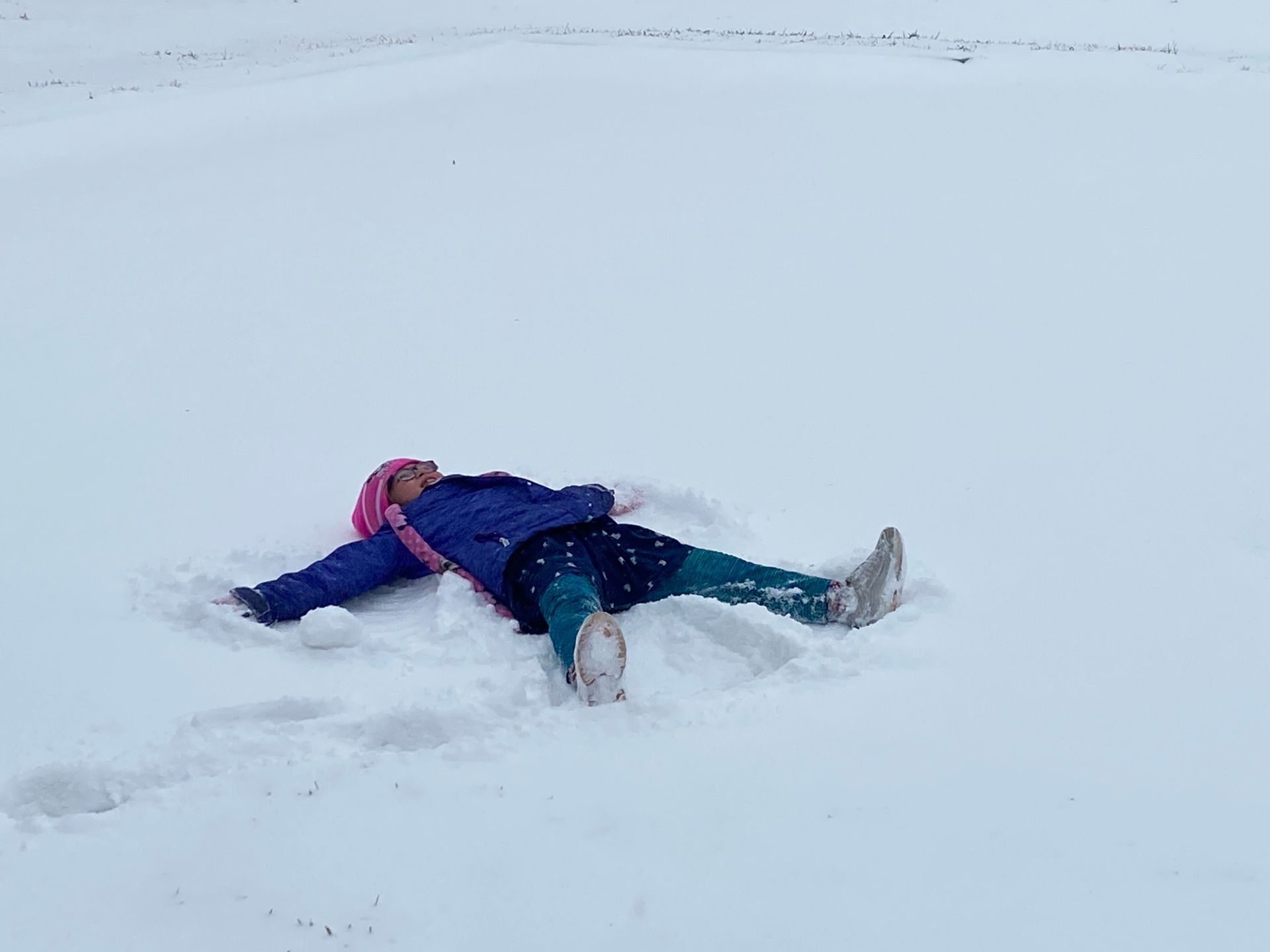
We saw a number of water connections still hooked up, and after the second very cold night, with burst water filters. It seemed everyone was trying to get their propane tanks filled. Which was fine when there was campground power – but filling propane tanks involves a heavy-duty pump – that needs electricity! When power did come back on, it didn’t take long to empty the campgrounds propane supply.
Power was out from 4 am, until 10 PM the next day. Fortunately, we had power for the coldest night. My calculations showed we could make it through that night on battery but I wasn’t happy about how low the batteries would get (less than 20%) which didn’t leave a lot of room for calculation error. It went down again at 9 am the next day for several hours, then came back that afternoon. While we could have barely survived on our batteries that second night with 9-degree weather, but I have no idea how many in the campground could – at least without running their generators ALL NIGHT, which for many would involve a cold, dark of night, gas tank refilling…… IF they had gas.
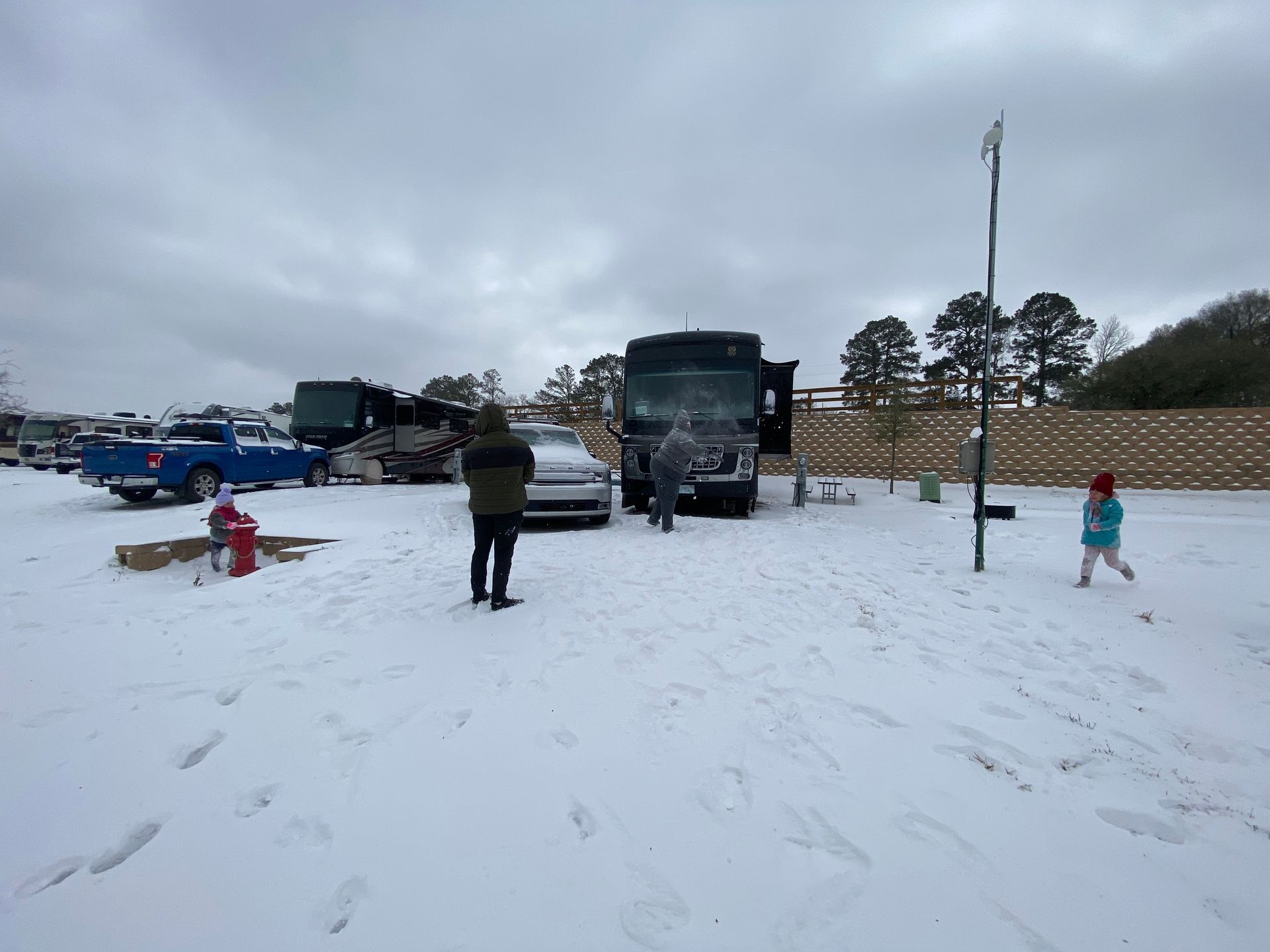
Late the second day, I was out front of our RV on the street and a person driving by asked if power was back on yet. I told him, nope. He relayed a story about trying to find gasoline. One store (Kroger) was open, but their gas station was out of gas. The nearby Loves station was open and had gas, but the line to get to a pump was AN HOUR LONG!
That morning I went out to top off the freshwater tank because there are neighborhoods in the area with boil orders due to low water pressure from all the broken pipes. Not frozen underground pipes, but frozen pipes under and inside houses or in the water plants themselves. I was worried the campground might lose water pressure as well. I nearly had to wade to the side of the rig because there is an 8-inch drain from the hill behind us that empties right between our site and our daughters. The flow was spreading out and covering the concrete pad under our RV. I have plastic “steppingstones” for helping me stay out of the mud – I arranged them to help redirect the edge of the flow that was heading our way. I managed to redirect the offending water toward the ditch instead of our RV pad. Water would be draining out of that hill for days, including after the temps drop low enough to freeze most everything flowing out.
Takeaways:
You (we) generally have no idea how the local utility infrastructure is maintained or how susceptible it would be to severe cold, high winds, flash floods or interruptions in fuel supply, albeit gasoline, natural gas, diesel etc. As RVers, we need to be responsible for our own resources as much or more than the average homeowner.
Another shortage – communication. Both from the state power grid and the campground. Estimates that were published as to when power might be restored were always late, vague and inaccurate. Communication from the campground was also missing. Perhaps they never had a way to notify everyone as to current issues. ALL campers should have been notified to empty their dirty tanks, fill their clean water tank, put their hoses away, to not dump during hours when power was out and seek gas and propane supplies in advance of the storm. All campers should have figured these things out for themselves, but many needed to be told but weren’t. You may wonder about the no dump rule. This park, because it exists across a valley, used lift pumps for sewage. In several low areas in the park, there were buried sewer tanks with power and pumps to take sewage from full hookup sites and pump it uphill to wherever the sewage system or connection to municipal system was located. One of these tanks had “water” overflowing out of it during the power outages. There were no backup generators on site.
While walking dogs, we saw a several dump hoses in the top of the dumpster that had been broken in half – with solid ice sticking out. I presume someone tried the “leave the faucet dripping” routine which is absolutely NOT the thing to do in an RV in freezing weather. We saw multiple burst water filters on our dog walks as well.
Once power was reliably restored, the only effect on us was some extra worry and planning, a bit of extra expense for heater and lights and a couple of days of “adventure”. We came through better than thousands of Houstonians.
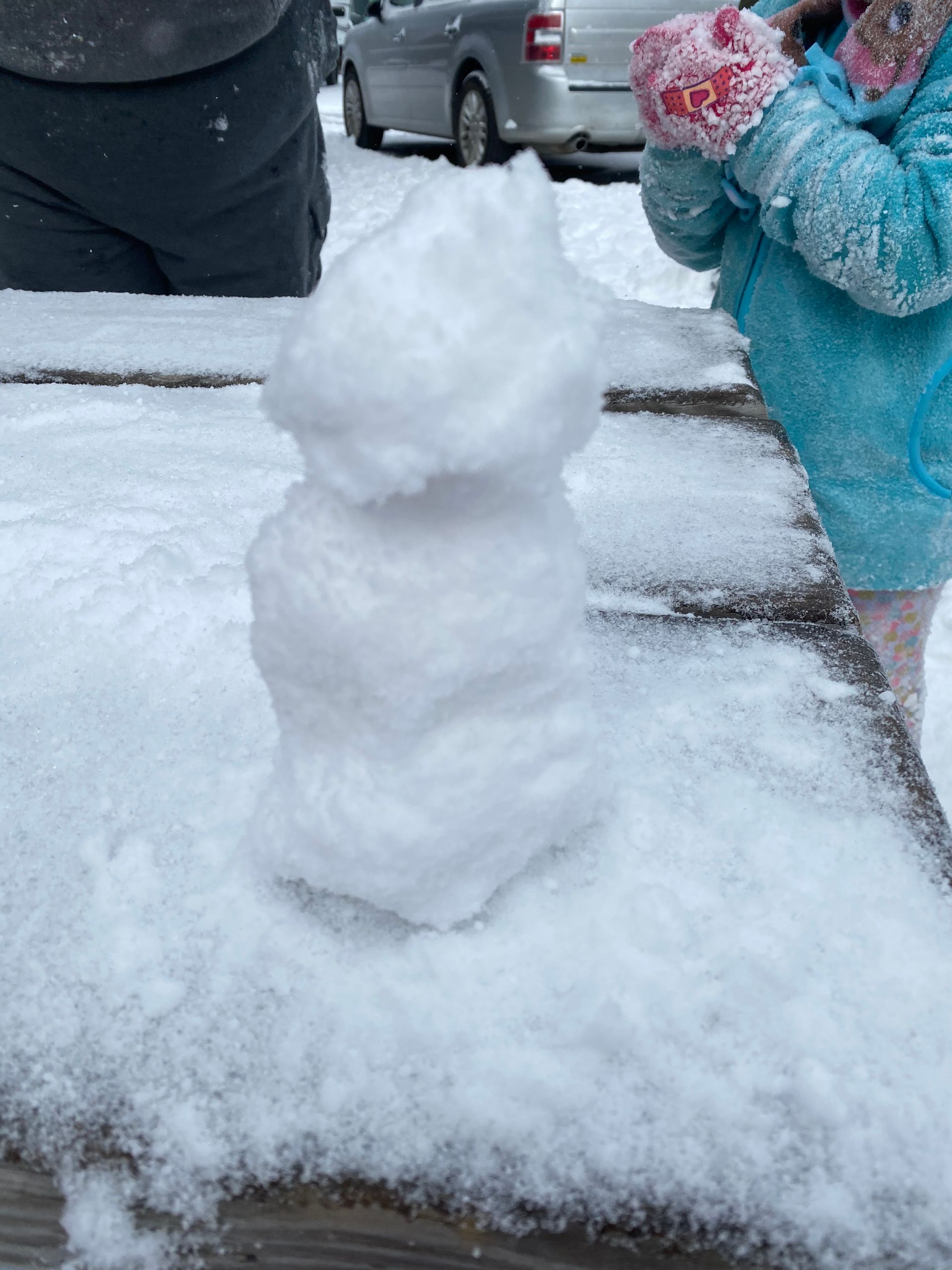
Other blogs you might like...

